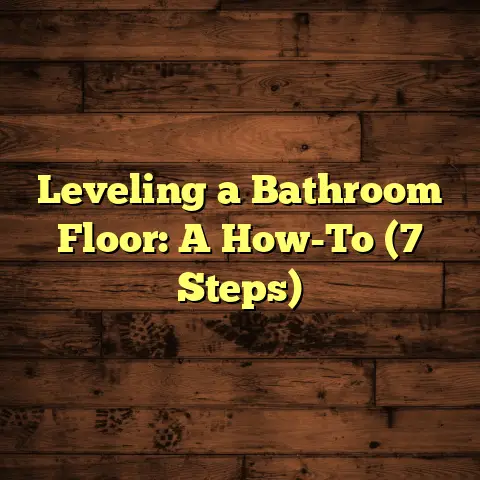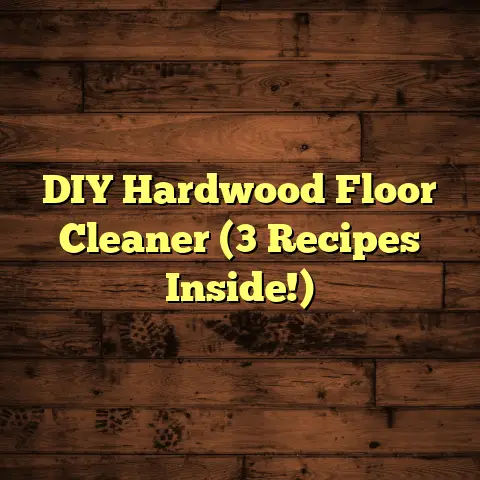Waxed or Polyurethane Floors? (1 Min Test)
One thing I’ve learned is that homeowners and designers are always looking for that perfect balance: flooring that not only looks amazing but also fits their lifestyle.
It’s not just about aesthetics; it’s about finding a solution that can handle the wear and tear of everyday life while still looking its best.
That’s where the choice between waxed and polyurethane floors comes in. These are two very different types of finishes, each with its own set of characteristics, advantages, and disadvantages.
In this article, I’m going to break down everything you need to know about waxed and polyurethane floors, so you can make an informed decision based on your unique needs and preferences. Let’s dive in!
Section 1: Understanding
Flooring Finishes
First things first, let’s talk about what flooring finishes actually are and why they’re so important.
Think of a flooring finish as a protective layer that sits on top of your wood floors. It’s like a shield that guards the wood from all sorts of potential damage.
Why are Finishes Important?
- Protection: Finishes protect the wood from scratches, dents, and everyday wear and tear.
- Moisture Resistance: They help prevent moisture from seeping into the wood, which can cause warping, swelling, and even rot.
- Stain Resistance: Finishes create a barrier that prevents spills and stains from penetrating the wood.
- Aesthetics: They enhance the natural beauty of the wood, bringing out its grain and color, and adding a desired sheen level.
There are many different types of flooring finishes out there, but today we’re going to focus on two of the most popular: wax and polyurethane.
Wax finishes have been around for centuries, offering a traditional, natural look. Polyurethane, on the other hand, is a more modern option known for its durability and ease of maintenance.
Section 2: Waxed Floors
2.1 Characteristics of Waxed Floors
Let’s start with waxed floors. What exactly are they, and what makes them unique?
Composition of Wax Finishes
Wax finishes are typically made from natural waxes like beeswax, carnauba wax, or a blend of different waxes. These waxes are often mixed with solvents to make them easier to apply.
How Wax Finishes Work
When you apply a wax finish to a wood floor, the wax penetrates the surface and creates a protective layer. This layer fills in the pores of the wood, making it smoother and more resistant to moisture and stains.
Aesthetic Appeal
One of the biggest draws of waxed floors is their natural look and feel. Wax finishes tend to enhance the wood’s natural grain and color, giving it a warm, inviting appearance.
They also have a unique tactile quality that many people find appealing. Waxed floors feel soft and smooth underfoot, unlike the harder, more plastic-like feel of some polyurethane finishes.
2.2 Advantages of Waxed Floors
So, what are the specific benefits of choosing a waxed floor?
Ease of Application and Reapplication
One of the biggest advantages of wax finishes is how easy they are to apply. You can apply wax with a cloth, a brush, or even a buffing machine. And if you need to touch up a worn area, it’s a simple matter of reapplying wax to that specific spot.
Custom Sheen Level
Wax finishes allow you to control the sheen level of your floors. You can achieve anything from a matte finish to a high-gloss shine, depending on the type of wax you use and how you apply it.
Eco-Friendliness
Many natural wax products are eco-friendly, made from renewable resources and free from harsh chemicals. If you’re looking for a green flooring option, waxed floors can be a great choice.
2.3 Disadvantages of Waxed Floors
Of course, waxed floors aren’t without their drawbacks. Here are some of the challenges you might face.
Maintenance
Waxed floors require regular maintenance to keep them looking their best. You’ll need to re-wax them every few months, depending on the amount of traffic they receive.
Susceptibility to Water Damage and Staining
Wax finishes aren’t as resistant to water damage and staining as polyurethane. Spills need to be cleaned up quickly to prevent them from penetrating the wax layer and damaging the wood.
Limited Durability
Compared to polyurethane, wax finishes are less durable. They’re more prone to scratches, dents, and wear and tear, especially in high-traffic areas.
Section 3: Polyurethane Floors
3.1 Characteristics of Polyurethane Floors
Now let’s turn our attention to polyurethane floors. What are they made of, and how do they differ from waxed floors?
Chemical Composition
Polyurethane is a synthetic resin that forms a hard, durable coating when it dries. It’s made from a combination of polymers, solvents, and additives.
Oil-Based vs. Water-Based
There are two main types of polyurethane finishes: oil-based and water-based.
- Oil-based polyurethane is known for its durability and rich, amber tone. It tends to yellow over time, which can enhance the look of some wood species.
- Water-based polyurethane is clearer and less likely to yellow. It also has lower VOC (volatile organic compound) emissions, making it a more eco-friendly option.
3.2 Advantages of Polyurethane Floors
What are the benefits of choosing a polyurethane finish for your floors?
Durability and Longevity
One of the biggest advantages of polyurethane is its durability. It forms a tough, protective layer that can withstand heavy foot traffic, scratches, and dents.
Resistance to Moisture, Stains, and Scratches
Polyurethane is highly resistant to moisture, stains, and scratches. This makes it a great choice for homes with kids, pets, or anyone who wants a low-maintenance flooring option.
Low Maintenance
Compared to waxed floors, polyurethane floors require very little maintenance. You can usually get away with just sweeping or vacuuming them regularly and occasionally damp-mopping them.
3.3 Disadvantages of Polyurethane Floors
Like waxed floors, polyurethane floors have their downsides.
Potential for a Plastic-Like Appearance
If not applied correctly, polyurethane can sometimes give floors a plastic-like appearance. This is especially true with high-gloss finishes.
Longer Curing Time
Some polyurethane finishes, particularly oil-based ones, can take a long time to cure completely. This means you’ll need to avoid walking on the floors for several days after they’ve been finished.
Environmental Concerns
Some synthetic polyurethanes contain harsh chemicals and emit VOCs, which can be harmful to the environment and human health. However, there are now many low-VOC and water-based polyurethane options available.
Section 4: Customizability of
Waxed vs. Polyurethane Floors
When it comes to flooring, customizability is key. You want a finish that not only protects your floors but also allows you to achieve the exact look you’re going for. So, how do waxed and polyurethane floors stack up in terms of customizability?
Waxed Floors: Easy to Tint and Color
One of the great things about waxed floors is how easy they are to tint or color. You can add pigments or stains to the wax to create a custom color that perfectly matches your décor.
This is a great option if you want to give your floors a unique, one-of-a-kind look.
Polyurethane Floors: Range of Sheens
Polyurethane finishes come in a range of sheens, from matte to high-gloss. This allows you to tailor the look of your floors to fit your specific design style.
For example, a matte finish can give your floors a more rustic, natural look, while a high-gloss finish can create a sleek, modern appearance.
Unique Patterns and Textures
Both waxed and polyurethane finishes can be used to create unique patterns and textures on your floors.
With wax, you can use different application techniques to create a textured surface. With polyurethane, you can use stencils or other tools to create patterns.
Section 5: Performance Comparison
Okay, let’s get down to the nitty-gritty. Here’s a detailed comparison chart that breaks down the performance of waxed and polyurethane floors across several key factors:
| Feature | Waxed Floors | Polyurethane Floors |
|---|---|---|
| Durability | Low | High |
| Maintenance | High (frequent re-waxing) | Low (occasional cleaning) |
| Appearance | Natural, warm | Can be plastic-like if not applied correctly |
| Environmental Impact | Can be eco-friendly (natural waxes) | Can be environmentally harmful (VOCs) |
| Cost | Lower initial cost, higher long-term cost | Higher initial cost, lower long-term cost |
| Water Resistance | Low | High |
| Stain Resistance | Low | High |
| Scratch Resistance | Low | High |
Scenarios Where One Finish Outperforms the Other
- High-Traffic Areas: Polyurethane is the clear winner here. Its durability and resistance to wear and tear make it ideal for areas that see a lot of foot traffic.
- Low-Traffic Areas: Waxed floors can be a great choice for areas that don’t get a lot of use, such as bedrooms or formal living rooms.
- Homes with Pets or Kids: Polyurethane is the better option for homes with pets or kids, as it’s more resistant to scratches, stains, and spills.
Testimonials
“I chose waxed floors for my living room because I loved the natural look and feel,” says Sarah, a homeowner in California. “But I quickly realized that they required a lot more maintenance than I was prepared for. I ended up switching to polyurethane, and I’m much happier with the durability.”
“As a flooring contractor, I’ve worked with both waxed and polyurethane floors,” says Tom, a contractor in New York. “Polyurethane is definitely the more practical choice for most homeowners, but waxed floors can be a great option for those who are willing to put in the extra effort to maintain them.”
Section 6: Conclusion and Final Thoughts
So, there you have it! We’ve covered everything you need to know about waxed and polyurethane floors, from their characteristics and advantages to their disadvantages and performance.
Key Takeaways
- Waxed floors offer a natural look and feel, but require more maintenance and are less durable than polyurethane.
- Polyurethane floors are durable, low-maintenance, and resistant to moisture, stains, and scratches, but can sometimes have a plastic-like appearance.
Choosing the Right Finish
When choosing between waxed and polyurethane floors, it’s important to consider your lifestyle, preferences, and priorities.
If you’re looking for a low-maintenance, durable flooring option that can withstand heavy use, polyurethane is probably the better choice.
But if you’re willing to put in the extra effort to maintain them, waxed floors can be a beautiful and unique addition to your home.
Ultimately, the best flooring finish is the one that meets your specific needs and fits your personal style.
References
- National Wood Flooring Association (NWFA)
- U.S. Environmental Protection Agency (EPA)
- “Understanding Wood Finishing” by Bob Flexner





